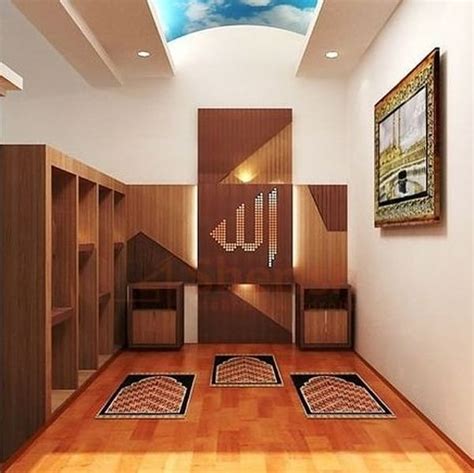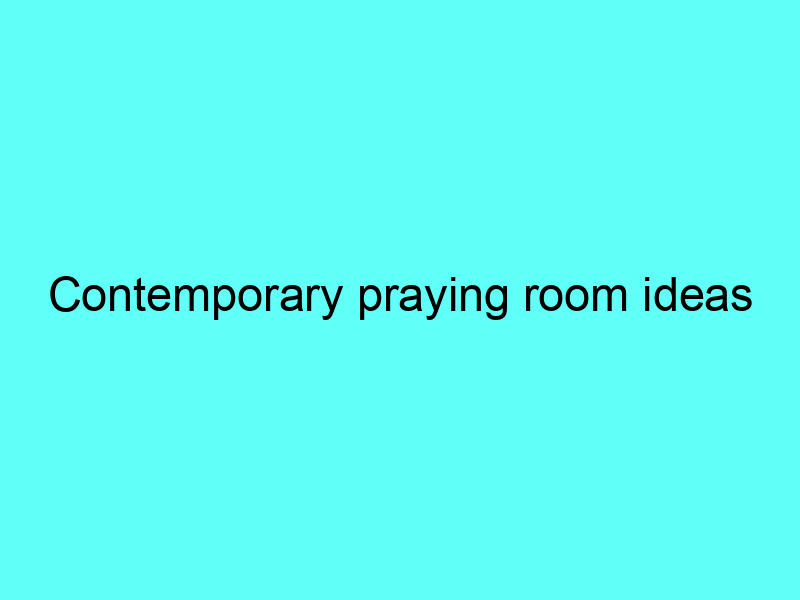Contemporary Prayer Room Ideas: Designing a Sacred Space for Worship and Reflection
Introduction:
Contemporary praying rooms have gained popularity in recent years. These rooms are designed to provide a peaceful and comfortable space for prayer and contemplation. The contemporary praying room has become an important part of any home or public space, providing a retreat for individuals who need to escape from the fast-paced world and find a serene place to connect with their spirituality.
The importance of a contemporary praying room cannot be overstated. It is a place where individuals can go to meditate, pray, reflect, and find peace with oneself. In today’s world, where everything is fast-paced and everyone is connected through technology, there is a need for a quiet space where one can disconnect from the noise and chaos and connect with one’s spiritual side. A contemporary praying room provides this much-needed space and allows individuals to take a step back from their busy lives and find solace.
Today, we will explore some contemporary praying room ideas that will inspire you to create an inviting and peaceful space in your home or public area.
Minimalist Praying Room:

Minimalist design has been gaining popularity in recent years, and for good reason. This style of design focuses on simplicity and functionality, creating spaces that are clean, uncluttered, and calming. When it comes to a praying room, a minimalist design can be particularly effective in helping to create an environment that is conducive to peaceful prayer and reflection. In this article, we’ll explore the benefits of having a minimalist praying room, as well as the elements that are essential to creating a successful design.
Simplicity:
Minimalism is all about simplicity, and a praying room is no exception. By keeping the design clean and clutter-free, you can create a sense of calmness and serenity that is essential for prayer. This means keeping the room free of unnecessary decorations and furnishings, and focusing instead on a few key elements that will create a peaceful atmosphere. For example, a simple prayer rug, a small shelf for religious texts, and a candle or two can all be effective in creating a minimalist and relaxing praying room.
Focus on Functionality:
Another key element of minimalist design is functionality. This means creating a space that is both practical and aesthetically pleasing. When it comes to a praying room, functionality is especially important. You want to create a room that is easy to use and conducive to prayer. This could mean incorporating features like a built-in niche for prayer, a comfortable chair or cushion, and good lighting to create a calming ambiance.
Neutral Colors:
Neutral colors are a hallmark of minimalist design, and they can be especially effective in a praying room. Colors like white, beige, and light gray can create a sense of calm and tranquility, helping to create a space that is peaceful and conducive to prayer. When it comes to accents and decorations, you can add a pop of color with items like a throw pillow or small plant, but be sure to keep the overall color scheme neutral and restrained.
Lighting:
Lighting is a crucial element of any praying room, and it’s particularly important in a minimalist design. Soft, subtle lighting can help to create a calming atmosphere, while harsh or bright lighting can be distracting and disruptive. You may want to consider incorporating a dimmer switch or using lamps with warm, soft bulbs to create a relaxing ambiance. Natural light can also be effective, so if possible, try to position the praying room near a window that lets in plenty of light.
Peaceful Atmosphere:
At the end of the day, the goal of any praying room is to create a peaceful and relaxing atmosphere that allows for reflection and prayer. In a minimalist design, this means focusing on simplicity, functionality, and a few well-chosen accents that help to create a calm and serene environment. By paying attention to these key elements, you can create a space that is perfect for quiet contemplation and prayer.
Conclusion:
A minimalist praying room can be a powerful tool for fostering peace and tranquility in everyday life. By focusing on simplicity, functionality, and a few well-chosen accents, you can create a space that is conducive to prayer and reflection. Whether you’re designing a new praying room or simply looking to update an existing space, a minimalist design can be an effective way to create a peaceful environment that will enhance your daily life.
Natural Praying Room:

A natural praying room incorporates materials like wood, stone and bamboo to create a serene atmosphere that invokes a sense of calmness. The very essence of nature is captured within the space which in turn helps harness the soothing effects of nature on the mind and soul. The use of these natural materials also brings a sense of warmth to the room thus creating a homely feel. Such spaces are designed with simplicity and minimalism in mind, creating the perfect environment to connect with God.
Wood is an exceptional material in creating an inviting and natural praying room. The texture and color of wood add warmth and calmness to the room. Whether it is exposed raw wood or painted, it brings comfort to the space. In addition, bamboo is a renewable resource and is popular for interior design purposes as well as for decorating a praying room. Bamboo is a versatile building material that can be used to create furniture or even wall paneling. It is a perfect material for the prayer room as it is durable and hardy, and unlike other woods, it can withstand moisture.
Finally, use of stone is also beneficial in creating natural prayer rooms. Its rough texture and muted tones create an appealing and calming environment. Chipped or polished stones can be used to create features such as an altar piece which becomes the focal point of the room.
Designers are known to create natural prayer rooms by incorporating other natural elements such as plants, water features and natural lighting. The sound of water flowing, the scent of fresh plants and the natural light create an atmosphere of peace and tranquility.
Modern Industrial Praying Room:
Contemporary praying rooms are an opportunity to create a peaceful and serene space for individuals to disconnect from the outside world and focus on their faith. The use of industrial elements such as metal and concrete can transform a praying room into a modern and stylish space. With the rise of industrial-style interior design, incorporating these materials can be a perfect way to update any worship space and create a unique atmosphere.
In a modern industrial praying room, concrete can be used for the flooring, walls, and even the altar. The smooth surface of concrete creates a clean and minimalist look that will complement any metal accents that are added to the room. Concrete can also be stained or painted to add a pop of color that will bring warmth to the space.
Metal is a versatile material that can be fashioned into any shape or design to fit any décor style. In a modern industrial-style praying room, metal can be used for furniture, fixtures, and even wall paneling. Metallic finishes such as brass, copper, and chrome can be used to add a touch of luxury to the room, or metal can be left raw and unfinished to create a rustic and earthy atmosphere.
To complete the modern industrial look in a praying room, it is recommended to stick to minimalist décor choices. This can include simple lighting fixtures, understated art, and furnishings that are functional yet visually striking. The use of natural materials such as wood can also break up the dominance of metal and concrete, adding warmth and texture to the room.
Overall, creating a modern industrial praying room can help congregants feel connected to their faith in a contemporary and thoughtful space. The use of metal and concrete can help to add a modern sophistication while the minimalist decor can create a peaceful and serene atmosphere perfect for prayer and meditation.
Islamic Praying Room:
Islamic praying or a dedicated prayer room is an essential part of a Muslim household. It is a sacred space that provides a serene environment, enabling Muslims to connect with Allah. In the past, Islamic praying rooms were cluttered with traditional Arabic art, heavy curtains, and taboos that prevented proper airflow. Nowadays, contemporary Islamic praying rooms are simple, elegant, yet practical, making it easy for one to pray.
There are three vital elements of a Muslim praying room: privacy, simplicity, and cleanliness. These factors improve concentration, reduce distraction, and enhance a person’s state of mind. Let’s have a look at how these elements can be incorporated into a modern Islamic praying room design:
Privacy:
Privacy is of utmost importance in Islamic praying rooms, as it allows for undisturbed communication with Allah. In modern times, the requirement for privacy has been amplified by the need to escape from the chaos and fast-paced life outside. As a result, a praying room should be located in a quiet spot that is isolated from the rest of the house. If possible, the room should have a separate entrance. Furthermore, the windows should be opaque or frosted to prevent outsiders from spying on the occupants as they pray.
Simplicity:
Simplicity is another crucial element in Islamic praying room designs, as it helps in maintaining an uncluttered environment and nourishes a soulful presence. The room should be decorated minimally, with Islamic calligraphy or verses from the Koran, preferably painted white or light colors on the walls. Avoid stuffing the room with unnecessary decorations or furniture, as it will lead to a loss of focus. Instead, choose functional pieces of furniture like a prayer mat, a small rug, and cushions.
Cleanliness:
Cleanliness is an essential aspect of Islamic praying rooms, as it is believed to be half of faith. The room should be clean and free of any dirt, clutter, or even smells. It adds a sense of purity, as it is believed that Allah is pure, and discerns cleanliness. In contemporary designs, ensure that the room has adequate ventilation and natural lighting, as it will assist in maintaining optimal air quality. Furthermore, a separate area for ablution, with a small sink and a stool, should be allocated adjacent to the room.
Technology:
With the advent of technology, modern Islamic praying rooms have not been left behind. Some people opt to incorporate a sound system that plays Islamic devotional music or a recitation of the Qur’an. Depending on a person’s preference, they can even have a screen where they access Islamic apps or browse through Islamic books. However, it is important to keep in mind that technology should not interfere with a person’s concentration or instill an inappropriate and secular ambiance.
Conclusion:
A modern Islamic praying room design should emphasize privacy, simplicity, and cleanliness to foster a peaceful and spiritual environment. These elements encourage one to concentrate and develop a strong connection with Allah. Comfort is also an integral part of contemporary designs, making it possible for one to pray for extended periods. Consequently, we hope that this guide will assist you in creating a sacrosanct space in your home.
Meditation and Yoga Room:
In today’s fast-paced world, finding time to disconnect and unwind from the daily hustle and bustle has become more important than ever before. What better way to do it than by creating a meditation and yoga room in your home? The purpose of this space is to promote inner peace, tranquility, and a sense of calm. This article will explore some ideas on how to create a space that is perfect for yoga and meditation practices.
Choose a Room with Plenty of Natural Light
When it comes to choosing the right room for your yoga and meditation practice, natural light is key. This is because natural light has a calming effect on the mind and body, making it the perfect choice for your practice space. Consider choosing a room with large windows or skylights to allow as much natural light as possible. If your chosen room doesn’t have enough natural light, you can always install artificial lighting that mimics natural light.
Use Soft Colors to Create a Calming Atmosphere
The colors you choose for your meditation and yoga room can have a huge impact on the atmosphere of the space. To promote relaxation and calmness, opt for soft, muted hues such as light blues, greens, and earthy tones. Avoid bright, bold colors that can be distracting and overwhelming. If you’re not sure which colors to choose, consult with an interior designer, and also keep in mind your personal preferences and taste.
Add Plants and Other Natural Elements
Incorporating plants and other natural elements into your meditation and yoga room can help to create a peaceful and relaxing oasis. Plants not only add a pop of color and beauty but also help purify the air and increase oxygen levels. Other natural elements that you can consider adding to your space include stones, seashells, or water features. Be creative and personalize your space with the elements that resonate with you the most.
Choose Comfy and Supportive Yoga Mats and Pillows
Comfort is key when it comes to yoga and meditation practices. Choosing the right yoga mat and pillows can make a significant difference in your practice experience. Opt for comfortable, non-toxic, and eco-friendly mats with good grip and thickness. Pillows and cushions are also essential for providing comfort and support during seated meditation or restorative yoga poses, choose them based on your preference for material, shape, and color.
Keep Your Space Clutter-Free and Clean
A cluttered space can be distracting and can disrupt the balance of your yoga and meditation practice. Keep your space clean, uncluttered, and well-organized. Invest in storage solutions, such as baskets or shelves, to keep everything neatly contained. Regular cleaning, decluttering, and air-purifying can help maintain a sense of purity and freshness that is essential to fostering a mindful practice.
Personalize Your Space with Decorative Touches and Inspirational Items
Your meditation and yoga room is your personal space, and it should reflect your personality and inspirations. Add decorative touches and inspiring quotes or images that resonate with you. Choose a piece of wall art or a rug that brings comfort and calmness. Accents like aromatherapy diffusers or candles can also fill the room with scents that promote relaxation and focus.
In conclusion, your meditation and yoga room should be a comfortable and personalized space that inspires, relaxes, and rejuvenates. By incorporating natural light, soft colors, plants, comfy mats, and pillows, a clean, uncluttered space with inspiring and decorative touches, you will create a sanctuary where you can unwind, reflect and connect with yourself.
Introduction:
A praying room is a private and peaceful space designed for individuals to meditate, prayer and reflect. It is essential to have a dedicated space that fosters introspection and spiritual growth. In modern times, the concept of contemporary praying rooms is becoming increasingly popular. These rooms not only promote spiritual growth but also add a touch of elegance to the interior of the house. In this article, we will discuss some contemporary praying room ideas that will help you create an atmosphere that inspires and motivates.
1. Minimalist Praying Room:
A minimalist praying room is perfect for anyone who prefers a simple and clean design. The focus is on minimalistic décor, which means that the items in the room should be limited to only the essentials. Keep the color scheme neutral and use natural materials such as wood and stone. Place a small prayer rug in the center of the room and a low table for your Quran or other religious texts. This creates a peaceful and calming aura that fosters inner tranquility.
2. Nature-Inspired Praying Room:
The beauty of nature is second to none, and a nature-inspired praying room is perfect for those who find solace in the great outdoors. The design should include natural elements such as wood, stone, and plants. Use colors that are found in nature, such as green, brown, and blue. Consider adding a small indoor waterfall or a fish tank to create a soothing sound ambiance and aesthetic. This design promotes relaxation and helps individuals connect with nature, which is a fundamental aspect of spiritual growth.
3. Traditional Praying Room:
A traditional praying room features classic designs and architecture. Utilize traditional fabrics and materials like rich rugs, brass lanterns, and plush cushions. Add intricate, detailed patterns on curtains, wall art, and furniture pieces. The ambiance created is intimate and cozy, perfect for those who prefer a more conventional design. Surrounding yourself with these traditional elements provides a grounding connection to religious practices and values.
4. Modern Praying Room:
A modern praying room features contemporary designs and styles. Use unconventional materials like metal and glass, and choose bold and bright colors for an eye-catching and stimulating environment. Consider adding innovative LED lighting or elegant furniture pieces for that extra touch of modernity. This design is ideal for those who prefer to blend spirituality with modernity, creating a statement room that inspires and motivates.
5. Zen Praying Room:
The Zen praying room is inspired by Japanese simplicity and is perfect for individuals who seek peace and harmony. Use neutral colors such as white, beige, and brown, and add natural bamboo plants, beautiful stones, and simple wooden elements. Use natural lightening and simple furniture like a cushioned seating area or a small tatami mat to create a calming and peaceful environment that promotes mindfulness and relaxation.
6. DIY Praying Room:
A DIY praying room is perfect for individuals on a budget or those who enjoy a more hands-on approach. This is an opportunity to let your creativity and imagination run wild. One can repurpose an unused closet, attic or basement space. Use cushions, floor mats, and candles to create a cozy and warm environment. Add personal touches such as family photos or calligraphy art pieces, which reflect your spiritual beliefs and values.
7. Conclusion:
Constructing a contemporary praying room is a powerful way to promote personal spiritual growth and reflection. It is a space that one can connect with their inner self and create an environment that reflects their personal beliefs and values. The design should be simple, calming, and inspiring. There are no hard and fast rules, and each individual can create a room that is unique and personal. Whether it is a minimalist design or a traditional praying room, the idea is to create a space that brings one closer to their spirituality and inner peace.



